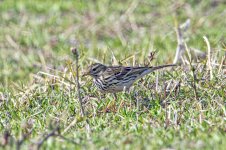I took this photo in January 2022, Samandağ-Hatay-Turkey (many accidental record in previous years). The supercilium of this bird is unusually bold, suggesting Olive-backed Pipit. But lacking buffish foreend and white spot on the ear plates questinable. I read some of the olive-backed pipits does not show these characters (especially in yunannensis). Opinions please. Thanks.






